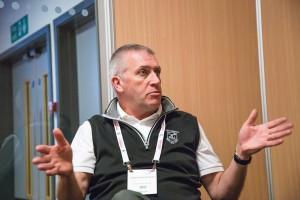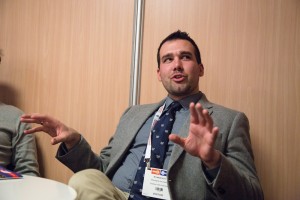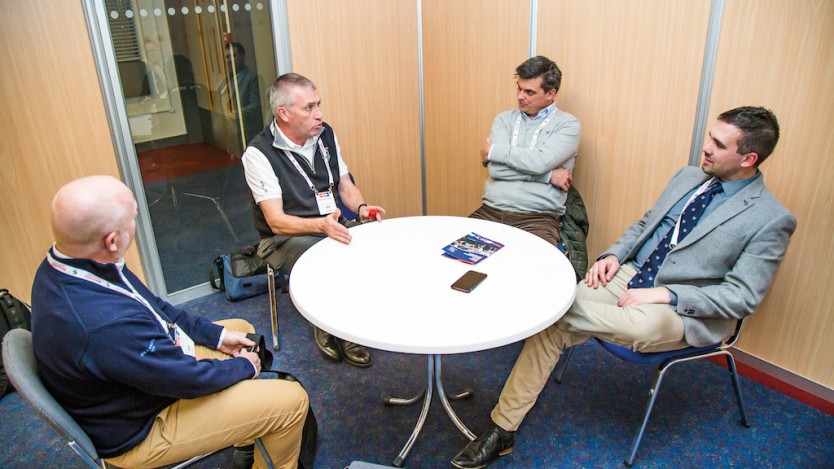How does a club move with the times? Why should golf embrace progressive ideas and are private members’ clubs being left behind by the proprietary sector? Golf at Goodwood’s Stuart Gillett is joined by Phil Grice, from Royal Norwich, Howley Hall’s Ryan Evoy and Chris Spencer, from North Berwick, to talk about the tricky task of balancing tradition with progression.
“In a traditional golf club structure, captains usually change every year and committees along with them. How does that affect what you do day-to-day?”
Chris Spencer: We have a business plan, and we have a section of it where the committee will decide what they would like to achieve for the year. Our captains do two years. It is getting the committee to buy into it – and the captain especially – and stick to it. They will sometimes go off on a tangent. I can go to them with something and they can make a decision in a couple of minutes and it is done. Other times, I am waiting nine months for someone to help me with the communications side of things.
Phil Grice: That’s a real issue isn’t it? I said to a couple of people ‘if you owned a football club, would you year-on-year change the manager?’ You just wouldn’t. In no other walk of life would you effectively have a CEO that changes year-on-year with no strategic aim.
Stuart Gillett: They want to leave their mark. From my point of view, it’s about the team. We have a believable path. It’s very simple and every business across Goodwood has it. That’s what you are going to do, how you are going to do it and when you are going to do it. So when your pro comes back from a conference and gets all excited about custom t studios you say ‘this doesn’t feature on our believable path.’ It can, but something might have to drop off. I have tremendous sympathy with people who work in situations where you have power brokers – people who want to ex their muscles. In my position, I am very lucky because I can push back and say ‘this is what we are doing. This is why we are doing it.’ I’m amazed how many clubs do not have that.
 PG: Simplistically, it is all about governance. The vast majority of private members’ clubs have no debt.So they can run as uneconomically as they do because they’ve been there 100 years and have no debt. A proprietor has an overdraft, has a mortgage or will want return on investment. His governance structure will be so much more focused on the long-term needs of the business and not the changing wind of the captain.
PG: Simplistically, it is all about governance. The vast majority of private members’ clubs have no debt.So they can run as uneconomically as they do because they’ve been there 100 years and have no debt. A proprietor has an overdraft, has a mortgage or will want return on investment. His governance structure will be so much more focused on the long-term needs of the business and not the changing wind of the captain.
“So does that system in private members’ clubs need reform?”
PG: I think it is (reforming). On January 1 this year, we went to a board of directors and I think we were late to the party. If you go to the England Golf growth hubs, they are talking about the proprietary sector and the reports they are getting back is they are doing great. They have seen the need for change and they have changed. Then you have got the members’ sector where they are slow to the party.
CS: I think proprietary courses have the ability to react quicker. There’s none of the politics. I think every secretary you will ever meet has the tale of the successful businessman that comes onto the committee and all his experience he’s had of being successful is parked at the door. He wants to leave his mark. Then there are those who don’t buy into it and just see it as ‘well, I’m on the committee.’ We have all been at meetings where the committee have opened up their envelope of papers as they have walked into the room. They’ve not sat down and looked, or done their prep, or read about it. There are those that do and are organised but there are those who don’t read it, don’t get it and will sit there and pontificate. Part of my role is to almost negotiate with the committee over our capital investment over the next three to five years. There’s a lot of negotiation and persuasion needed.
PG: We’ve got a model where, at the first step of the customer journey, is green fees. Fifty per cent of the golf income will come from variable membership, which is the points base we have, and the other 50 per cent for us in 10 years’ time will come from five, six and seven- day members. Two thirds to 3⁄4 of your members will be points-based members at three or four clubs. You try and put that to a members’ club and say ‘this is where the market is going.’ Whether you like it or not, the guy who is 18-40 is a golfing nomad. He doesn’t want to be loyal anymore. He wants to play golf at a number of different clubs. Members clubs say ‘You can get me 50 new guys who will give us £1,000 each because they should show the same loyalty I have for the last 50 years.’ That doesn’t exist any more.
 SG: One of the successes we’ve had is we have created an environment where people feel comfortable. We know what it is like. You walk into a little country pub for the first time. You don’t know anybody and everyone turns around and looks at you. How many golf clubs are like that? You’ve got to be welcoming. You’ve got to be friendly. Our success with ladies is they are not embarrassed or scared to hit a golf ball in front of people. How do you do that? You have got to have it as a mindset and have your whole team encourage people so they feel comfortable. It gives people a reason to come and want to be part of it. I am incredibly proud of how we have grown the game in the last five years.
SG: One of the successes we’ve had is we have created an environment where people feel comfortable. We know what it is like. You walk into a little country pub for the first time. You don’t know anybody and everyone turns around and looks at you. How many golf clubs are like that? You’ve got to be welcoming. You’ve got to be friendly. Our success with ladies is they are not embarrassed or scared to hit a golf ball in front of people. How do you do that? You have got to have it as a mindset and have your whole team encourage people so they feel comfortable. It gives people a reason to come and want to be part of it. I am incredibly proud of how we have grown the game in the last five years.
PG: What you are talking about is the cement between all the bricks. If people come in and feel comfortable and feel part of it then actually growing golf is easy.
SG: But it’s driven by a detailed vision. It’s a believable path that everyone buys into. Then it’s about the customer journey, the customer experience. That is the reason clubs are doing well. The reason proprietary clubs are doing relatively well, in the grand scheme of things, is actually they’ve adapted to that. Those members clubs, that are doing the same, will be bene ting as well. This notion that people don’t want to play golf, I think personally, is rubbish. People still want to play golf. The Rory factor is pretty strong and you see, at those places that get kids’ golf right, they want to do it.
Ryan Evoy: My first year I kind of sat back and observed really. I’ve been there 14 months now and one of the things I ran with was a social media platform. Twitter and Facebook weren’t big things where I was and we have run with that and seen a massive increase. People are talking to the golf club without us doing a little bit of work. We are in the middle of changing the board structure as well, from 12 members to almost a board of trustees of four and myself.
SG: What’s been the drive to do that? What’s the reason to do that?
RE: It’s just decision making. To make decisions day-to-day, you send emails out, you go to board meetings and half the members haven’t read the minutes from the last meeting or been through the prep work. A lot of work goes in to producing that and it lets you down. Decisions are not being made. It’s something I talked to my president about. He’s the one that ran with it and is happy to change the structure of the board. It has been quite good for me moving from a proprietary to a private members’ club to learn how different each are. It has been good. I am quite fortunate where I am. The board are progressive and have invested plenty of money into the course in the last four or five years. They let me get on with it.There are not many decisions I can’t (take). The major decisions – on expenditure – I go to them but, day-to-day things, it’s good.
“Do you ever hear the heritage, or history, of a club being used as an excuse not to do something?”
CS: Yes, it’s change. We are quite progressive.We are going through a similar thing on the governance side. The captain does a two-year period. First it’s captain elect, then captain and then off the committee. If the captain elect is off ill, or whatever, there is nobody really to step into his shoes. We are now looking at different models as to how we can have a better structure. We are looking at: do we go with a board of directors, do we go with a chairman,  heads of sheds and then just co-opt people on to different subs? It’s just to try and improve the way we run and make it more of a members’ club. It has always been about the visitor. When I first started at North Berwick, the nance committee said: ‘As long as we’ve got enough money in the bank, and the visitor income is good, that’s all we are bothered about.’ To an extent, that applies to this day. We want to make it more of a members’ club, rather than a club where members go but with lots of visitors. But with the confines of the club’s rules, and the lease, we have complications so we are unique in that respect.
heads of sheds and then just co-opt people on to different subs? It’s just to try and improve the way we run and make it more of a members’ club. It has always been about the visitor. When I first started at North Berwick, the nance committee said: ‘As long as we’ve got enough money in the bank, and the visitor income is good, that’s all we are bothered about.’ To an extent, that applies to this day. We want to make it more of a members’ club, rather than a club where members go but with lots of visitors. But with the confines of the club’s rules, and the lease, we have complications so we are unique in that respect.
PG: Can you introduce a points system?
CS: We wouldn’t look at something like that because I have got a three-year waiting list and a joining fee. I don’t need to go chasing membership. Having said that, as soon as a membership enquiry comes through, we treat it like gold dust. If someone turns up at the front door and asks for details, we drop whatever we are doing and go and speak to them. It’s important. They maybe join the Glen, on the East Links, who don’t have a waiting list and they are into the town. If golfers move to the area and want to join, then they’ve got a three-year wait. But if we get them involved in golf in the town, by joining the Glen, then it helps them. It’s about helping the town, rather than just helping ourselves.
 SG: We debated long and hard about what we’d call the waiting list. We didn’t want to do it. We spent 10 years being simple, affordable and flexible. All of a sudden, we are saying ‘we are not available anymore.’ So we are putting as much effort now into looking after and managing the waiting list going forward. You have a product that you are passionate about, you charge something for it and you have got to give that value for money. That is paramount. It still frustrates me when you go into clubs and you just get horrendous service. I think it is changing. I think it could change quicker.
SG: We debated long and hard about what we’d call the waiting list. We didn’t want to do it. We spent 10 years being simple, affordable and flexible. All of a sudden, we are saying ‘we are not available anymore.’ So we are putting as much effort now into looking after and managing the waiting list going forward. You have a product that you are passionate about, you charge something for it and you have got to give that value for money. That is paramount. It still frustrates me when you go into clubs and you just get horrendous service. I think it is changing. I think it could change quicker.
CS: Every club is unique but it is knowing the value of the service you are providing and making sure you stick to that value and doing your very best within the parameters of your rules, lease or whatever. If you do that and stick with it – because it will take time – then you will reap the benefits.
SG: The person walking through that door is at the heart of everything you do. We are in the customer service industry. We have to tailor the offering. So many business models of golf clubs are the way they were 30 or 40 years ago. Then, the man of the house would go out on a Saturday morning and not come back until 2 or 3pm in the afternoon after having four pints. As sexist as it may be, that was the harsh reality of it. We can’t do that now. We’re time constricted. The world has changed. The models haven’t changed. They are starting to now.
CS: We are challenging tradition and that’s the hardship. Some people don’t want that cup of tea to be really nice in a different pot and be £2.20 for three cups. They want it to be 80p.
SG: Is that tradition or change? Tradition of golf has got a place, but golf is a service. The nomads want to go and play golf. Price drives them. If you give people a service they’ll come back for more and they’ll pay a little bit extra.
This article was first published in The Golf Club Manager – the official journal of the GCMA. If you would like to receive the journal, either join the GCMA today, or subscribe to the magazine.
By GCMA




